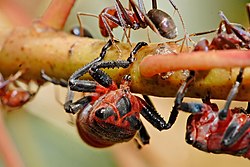Sap: Difference between revisions
m →References: remove extra square brackets |
|||
| Line 28: | Line 28: | ||
== References == |
== References == |
||
* |
*[http://www.gardeningknowhow.com/trees-shrubs/what-is-tree-sap.htm] |
||
* |
*[http://www.gardeningknowhow.com/trees-shrubs/how-to-remove-tree-sap.htm] |
||
{{DEFAULTSORT:Plant Sap}} |
{{DEFAULTSORT:Plant Sap}} |
||
Revision as of 05:40, 14 May 2012


Sap is a fluid transported in xylem cells (tracheids or vessel elements) or phloem sieve tube elements of a plant. The xylem cells transport water and nutrients throughout the plant. Sap flows through sapwood, which in turn produces carbon dioxide. When the CO2 builds up pressure in the tree, it forces the sap out through any holes or openings in the tree. That is why one can see sap oozing down a tree. When temperatures rise, sap flows more quickly because it becomes heated up. When temperatures become colder, sap tends to stay situated in the tree.
Xylem sap consists primarily of water, with hormones, mineral elements and other nutrients dissolved in it. Transport of sap in xylem is characterized by movement from the roots toward the leaves. Over the past century, there has been some controversy regarding the mechanism of xylem sap transport; today, most plant scientists agree that the cohesion-tension theory, along with evapotranspiration best explains this process.
Phloem sap consists primarily of water, with sugars, hormones, and mineral elements dissolved in it. It flows from where carbohydrates are produced or stored to where they are used. The pressure flow hypothesis proposes a mechanism for phloem sap transport.
Maple syrup is made from reduced sugar maple xylem sap. It is often from the Sugar Maple, or Acer saccharum. In some countries (e.g., Russia, Latvia, Estonia or Finland) it is common to collect the early spring sap of birch trees (so called "birch juice") for human consumption; the sap can be used fresh or fermented and contains xylitol.
Problems
Bacterial Canker is a disease which affects trees through holes in the trees. Bacteria makes its way inside the tree and can cause extra sap production. This disease wilts and makes trees die.
Slime flux is a disease which makes sap oozing. Its sour-smelling and slimy. It's gray when it dries onto trees after oozing out of them.
How to remove Sap
From hands and skin: Use nail polish remover, then soap and water.
From clothing: Use rubbing alcohol.
From hair: Use peanut butter.
